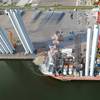If the world’s LNG trades evolve in the future as many expect, there will be significantly more work for ship repairers in the Atlantic Basin. There are, for the moment, only a few yards with such experience, including Izar (Spain), Sobrena (France), Keppel Verolme (Rotterdam), Blohm & Voss (Hamburg) and Grand Bahama Shipyard. However, there are reports that studies are under consideration to examine the feasibility of new drydocks and possibly expansion at existing repair facilities to cope with this new business.
Recent developments with respect to energy prices are likely to hasten such studies. With crude oil prices rising by nearly 15% over the last month alone, and certain key blends bursting through $40 a barrel, there is concern all round that the cost of energy could impose a dramatic dampener on today’s buoyant shipping markets while, at the same time, adding more urgency to the quest for long-term energy supplies other than crude oil.
Recent days have seen considerable volatility in crude prices and earlier this week, they hit record highs amid concern that current production levels are insufficient to fuel a number of booming economies, not least China. Of course, rising anti-American sentiment and an increasingly volatile Middle Eastern situation have added further uncertainty to a week in which Brent crude soared to more than $39.50, light US crude hit $41.70 and Malaysia’s Tapis, the country’s benchmark, also broke through $41.
Energy analysts are divided on future developments. Some believe that a likely increase in OPEC production could stall the rising price trend but others believe Middle Eastern concerns are playing into the hands of certain producers which have no hesitation in breaking rank with the oil producing cartel in the face of substantial short-term financial gains. The concern is, however, that prices could yet climb further. Fears of an impending shortage of US gasoline occurring simultaneously with Americans taking to the road at the end of May in what is puzzlingly called the “summer driving season” could mean that demand outstrips supply for some weeks. And although US gasoline stocks are significantly higher than a few weeks ago, they remain well below the average for this time of year.
However, for those hoping that greater diversification of energy sources could take some heat out of the situation, conclusions drawn recently by the US Energy Information Administration (EIA) will come as a disappointment. In its 2004 International Energy Outlook projections, the EIA reckons that oil will maintain its current 39% share in terms of energy supply, assuming governments do not change existing energy pricing policies or strategies. The EIA believes that global energy demand will rise by an average of 2.7% a year between 2001 and 2025, a total 54% altogether.
The good news for independent ship owners digging deeply in their pockets to fund new lng carriers on a speculative basis is that demand for natural gas in expected to rise faster than all other primary energy sources, maintaining an annual growth rate of around 2.5% compared with 1.9% for oil and renewables, according to the EIA study. However, with more than a third of the existing lng fleet currently on order and newbuild prices rising dramatically, the stakes are high.
Meanwhile, energy analysts see a fundamental shift in global lng trading patterns. Despite a number of key setbacks at proposed terminal developments in the US, the country’s energy strategists are determined that environmentally attractive lng, sourced from various regions outside the volatile Middle East, should help to hedge energy supply risk. And the US has plenty of that risk, consuming more than a quarter of the world’s annual global crude oil and natural gas production.
Featured videos

Inside the Electrified Truckable Tug

Tracking Foreign Vessels Working in the U.S. Jones Act Market

Inmarsat Enhances Service to Drive Digitalization
Subscribe for
Maritime Reporter E-News
Maritime Reporter E-News is the maritime industry's largest circulation and most authoritative ENews Service, delivered to your Email five times per week









